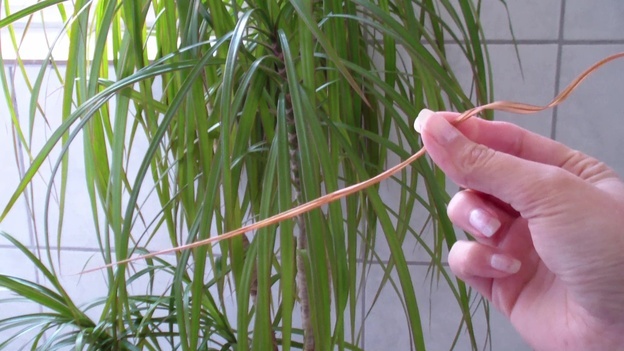VIDEO: Caring for a dragon palm properly
There are many different types of dragon palm. The houseplant, also known as the dragon tree or dracaena, is generally very easy to care for. Your shoot tips always grow towards the light, so you have to turn them every now and then. The ambient temperatures should ideally be between 15 and 30 degrees Celsius.
Pot the houseplant
-
Put the gravel in the flower pot. Put a drainage layer of gravel or expanded clay in the planter to ensure water drainage.

© Liane Spindler -
Fill up with potting soil. Put commercial potting soil on top.

© Liane Spindler -
Choose location. Place the palm in a light or slightly darker location, as it can cope very well with less light.

© Liane Spindler -
Water the plant. Place the houseplant in the bathtub for watering so that excess water can drain off directly.

© Liane Spindler -
Pour off excess water. Alternatively, you can also let excess water run into the planter. You have to pour this off regularly to avoid waterlogging.

© Liane Spindler -
Sprinkle leaves. Spray the dragon tree with water regularly as it needs high humidity.

© Liane Spindler -
Remove dried leaves. Remove dried leaves regularly.

© Liane Spindler
The dragon palm makes few demands on the care and is suitable for beginners. …
Location and propagation of the plant
The shoot tips of the dragon palm always grow towards the light, so you have to turn the plant every now and then. The ambient temperatures should ideally be between 15 and 30 degrees. The houseplant does not make any special demands on the substrate. Commercially available potting soil, such as you can get in hardware stores or garden centers, is completely sufficient.
You can use cut off shoots to propagate the houseplant. To do this, insert the cuttings into a substrate made up of equal parts sand and peat and put a transparent film over the flower vessel. You can just as easily use a small indoor greenhouse for this.
Maintain the dragon palm
You can cultivate the dragon palm in soil as well as hydroponically. When cultivating in soil, regular watering is required, which is not necessary with hydroponics. To make watering easier, you can immerse the entire vessel in water until the root ball is soaked with water.
Let the water drain well and put the pot back on a saucer or in a planter. Do not repeat this process until the substrate has dried well. The water requirement in winter is significantly lower. You should avoid waterlogging in both summer and winter.
You should only fertilize the plant during the growing season. For this you can give a complete fertilizer every one to two weeks, which you administer according to the manufacturer's instructions. The plant stays in the room as normal for the winter.
High humidity is particularly good for this plant. To achieve this, you can hydroponize the plant, or you can place a container of water near the dragon palm. Regular spraying with water is also recommended.
The Palm tree usually not or only when an instinct has died or is injured. In this case, cut the affected shoot at an angle. If you want to prune the plant because it is too big, you can easily carry out a radical cut, preferably always in spring. New shoots will quickly form again.
The dragon tree is relatively robust against diseases and pests. However, a lack of water or light can cause the plant to lose leaves. Damage is usually only caused by incorrect watering or an unsuitable location.
Should have pets in your household - specifically Cats - live, caution is advised. The dragon palm can cause poisoning in cats if they nibble on it, which then usually manifests itself as diarrhea.
Botanical profile of the dragon tree
| Botanical name | Dracaena draco |
| family | Agave family |
| origin | Canary Islands |
| height | up to 20 meters |
| Appearance | palm-like |
| Location | sunny, partial shade |
| best ambient temperature | 15-30 ° C |

